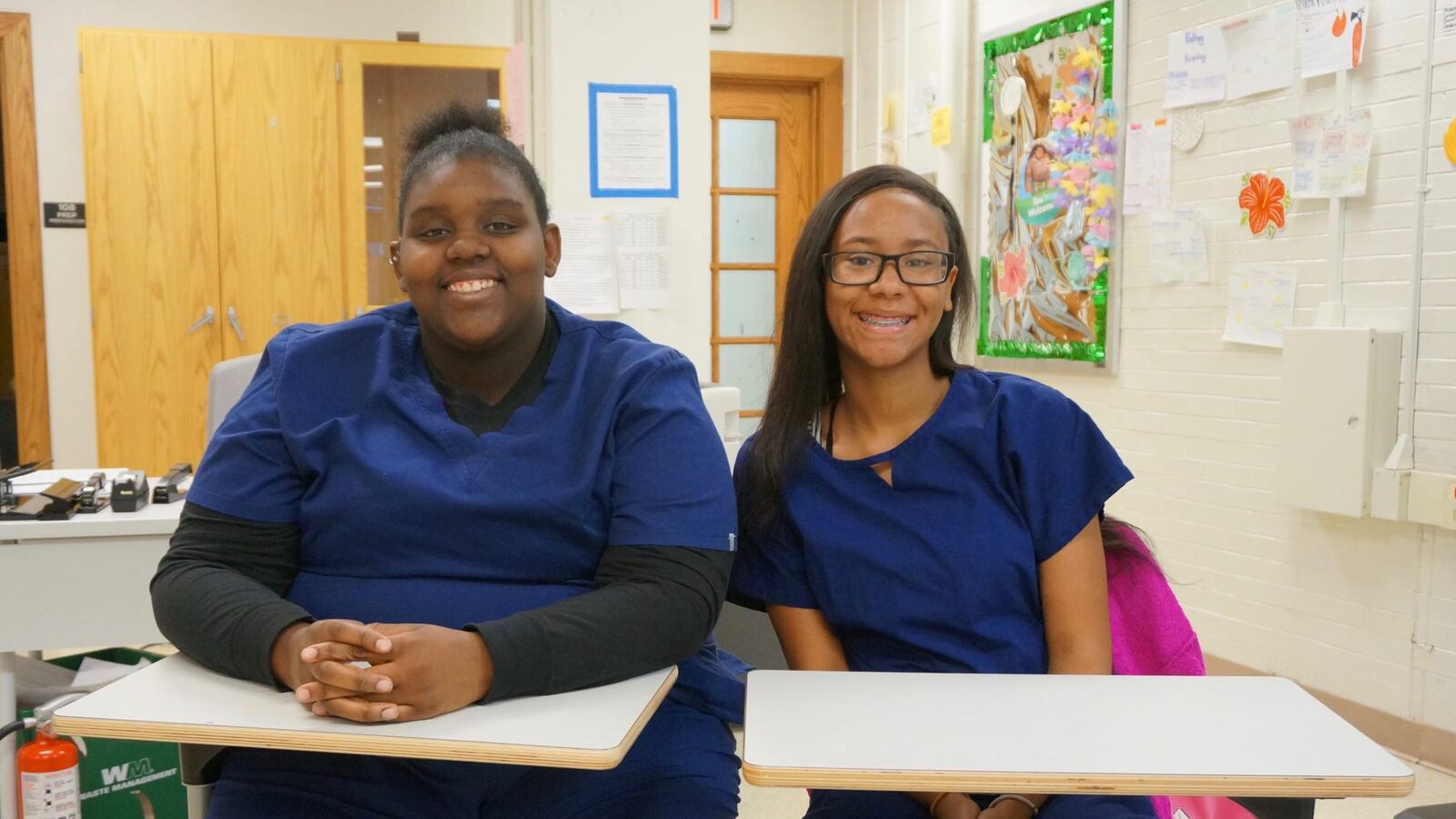A few days each week, seniors Shireah Washington and Antonia Dove end their school day at Crispus Attucks High School at about 11 a.m. Instead of spending the afternoon in the classroom, they work as certified nurses assistants at a senior care facility.
The jobs, which come with both paychecks and school credit, are part of a program the high school launched last year to help prepare students for careers in medicine. Six seniors, including Washington and Dove, who trained as CNAs and passed the state exam last year, now have jobs. The program was so successful that about 40 students are studying for the certification this year, according to the administration.
Nursing assistants’ work is not glamorous. For the eight-hour shift, the students take residents to meals, bathe them, and help them change. Some of the labor is strenuous — Dove said it takes upper body strength. Sometimes it’s off-putting — Washington said it takes a strong stomach. On slow days, it can just be a little dull, they said. But ultimately, it gives students a chance to see up close what it’s like to work with patients.
“It’s like stuff you see on TV,” said Dove, who wants to be a neonatal nurse. “You’re just seeing it in real life.”
The CNA program is part of Indianapolis Public Schools’ effort to revamp education for high school students by creating specialized academies that allow students to choose their school and program based on their interests. The academies cover a broad range of areas, from construction to rigorous college preparatory programs such as International Baccalaureate. But the central idea is that high school should prepare students for the careers they want to pursue.
The strategy is part of a career and technical education trend across the state and nation. Indiana is increasingly focused on connecting education and workforce development by encouraging high schools to give students more opportunities to explore careers and pursue internships. And national politicians from across the political spectrum support career and technical education.
At Attucks, there are two academies: health science and teaching, learning, and leading. The CNA training is part of the nursing track, one of four paths in the health science academy. The others are physical therapy, health informatics, and Project Lead the Way biomedical sciences.
Career education sometimes has a negative connotation as a program for students who can’t perform academically, said Mee Hee Smith, career academy coordinator at Attucks. But the health science academy has rigorous programs, she said.
For students to qualify for the CNA program, they must have a 3.0 grade point average, good attendance, and no discipline issues. The state also requires them to pass criminal background checks and health exams before they can begin clinical work with patients.
In addition to allowing them to earn credentials in high school, the CNA program can help “catapult” students into a two- or four-year degree program, Smith said. When students are applying to colleges, graduate programs, and jobs, they will already have experience working with patients and a state credential.
“When Shireah goes and finishes her four-year degree and then applies to med school, she gets to put that on her applications,” Smith said. “The hope is that she uses this experience and uses that to her advantage and maybe gets ahead.”
It’s also a chance to make some money. Students working as CNAs are paid between $11 and $13 per hour, depending on whether they are working early or late hours.
Dove is saving up to pay for expenses at college, like what she will buy for her dorm. Washington has been a little freer with her spending, buying clothes and gear for volleyball. “I just feel like I’m rich,” Washington said with a laugh.
But Washington, who wants to be a pediatrician, also takes her job seriously. “If I was anywhere else, I wouldn’t have had this experience,” she said.
While CTE has been embraced by politicians in recent years, there are some concerns about students focusing on career-specific skills in high school. Some question whether the skills are taught as a substitute for broad knowledge and whether students will have the general skills needed to adapt in a changing workforce. Others raise concerns about whether students from economically disadvantaged families or students of color are being steered toward CTE.
CNAs don’t make great money — the median pay is $12.21 per hour, according to the Indiana Department of Workforce Development. But if students pursue further education, it could open the doors to lucrative, in-demand occupations. Health care is projected to add more than 77,000 new job openings, including about 3,000 openings for nursing assistants, by 2026.
When principal Lauren Franklin took over at Crispus Attucks High School three years ago, the school was a medical magnet on paper. But there were only a few medical courses, and students could not take them until 10th grade, she said. Franklin set out to change that by adding more medical classes to the curriculum and helping students learn what medical careers would be like.
The nursing assistant program is part of that shift. It offers students the opportunity to work in medical settings with patients while they are still in high school. For some teens, it reaffirms their desire to go into medicine. But for others, it can change their perspective. Over the course of the first year, many students decided they didn’t want to continue the CNA training, said Franklin.
“I think people tend to romanticize it,” she added. “There were kids who … go to clinicals and they see blood for the first time, and it’s like, ‘thought I wanted to be a doctor, nevermind.’ ”
Ultimately, Franklin hopes the academies will give students a more concrete sense of what their future holds. “It gives kids that something to hope for and that something to strive for,” she said.

